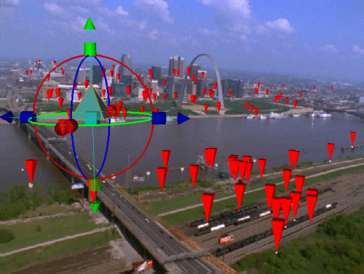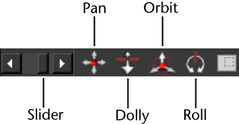The 3D
View shows the following from an arbitrary viewpoint:
- Cameras
- Tracking information
- Point Labels,
showing the point names.
- 3D Markers,
or 3D Helpers, displaying the estimated 3D points as customizable
3D Helpers (cones, pyramids, crosses). A link is drawn between the
2D reprojections and the corresponding 3D points if available.
- Manipulator Axes
- A 3D planar Grid
- Non-physical objects: Lights and Relations
- Built-in contours
- The estimated Camera Path
- The reference coordinate system
- 3D objects created directly in MatchMover
or imported. See
Working with 3D objects.
The default 3D
View is in the Free Camera mode
with the image plane displayed. By clicking on the image plane,
you are able to tweak its displayed depth by using the displayed
translation manipulator.
Toggle
the image plane display by selecting Display > Background
Image.
In the 3D
View window you can switch to Lock on Camera mode.
See
Lock on Camera mode.
The view constrains the camera to see the image as the background.
When you place a 3D object
within the 3D View window, MatchMover provides
manipulators that you can use to edit them. See
Editing 3D primitives and objects.
NoteTo change the color of the 3D View background,
the camera, or the camera path, select Edit > Preferences,
click the Color tab in the User
Preferences window, and change the color of the corresponding
sample box.
You can create tracks
in the 3D View in the same way as in
the 2D View. See
Working in 3D mode.
Displaying the 3D View attributes
By default the 3D
View shows a grid and axes with a perspective viewing,
the camera path with its corresponding image plane, and the reconstructed
points.
You can display or hide
points’ attributes by either:
- Selecting Display from the
main menu then clicking on the attribute in the pop-up menu.
- Right-clicking in the 3D
View and selecting Display and
an attribute from the pop-up menu.
For Point
Labels and 3D Marker Styles attributes, a
single diamond defines that the attribute is displayed for the selected
point.
If you click again, two
diamonds appear beside the attribute defining that the selected
attribute is displayed for all points.
No diamonds means that
this attribute is not displayed.
For all other options,
a check mark beside the option indicates that the option is active.
Clicking the option again hides the check mark and deactivates it.
You can also toggle the
3D object display in the Display menu:
- Flat shading
- Wireframe. A
backface culling option for wireframe mode also exists in the Display menu.
- Transparent
- Texture mode.
TipThe default shading
is smooth. See the Preferences window to change it
to real flat shading.
Select Display
> Inliners to show only the 3D points that are defined
in 2D at the current frame.
Changing the number of
wireframe divisions
You can change the number
of divisions in the wireframe of a selected object in the 3D
View mode.
- Select the Project tab
in the Parameters window.
- Enter a number in the 3D
Primitive Resolution text field. A smaller number reduces
the size of the intervals in the wireframe grid; a greater number
decreases their size.
Changing the size and shape
of the 3D Helpers
To change the size of
the 3D helpers:
- Select the Project tab
in the Parameters window.
- Select a 3D Helper Shape from Cone, Pyramid, or Cross.
Select Cross for a better feedback of
the 3D helpers’ orientation.
- Enter a number in the 3D
Helper Size text field. A smaller number reduces the
size of the 3D Helpers; a greater number increase their size.
NoteTo change the color
of a 3D point or the selected 3D point, select Edit
> Preferences, click the Color tab in
the User Preferences window, and change
the color of the corresponding sample box.
Changing the Grid Step
By
default, the 3D Grid Step has a value of 10.
You can change this value in the Subdivisions text
field in the Project tab in the Parameters
window.
Lock on Camera mode
The Lock
on Camera mode allows you to insert virtual objects and
constrains the computed camera to view the image sequence as the
background.
It can be considered
as a 2D view with superimposed 3D objects.
The Lock
On Camera mode allows you to display the same attributes
as the Free Camera mode.
To lock on a camera:
- Make sure that you are in the 3D mode.
- Do one of the following:
- Select View > Lock On Camera.
- Right-click in the 3D View window and
select Lock On Camera from the pop-up menu.
- Click the Lock on Camera icon
 in the
Navigation toolbar.
in the
Navigation toolbar.
NoteAs the Lock
on Camera mode includes the image sequence, you are viewing
the scene from the position of the estimated camera. Unlike the Free
Camera mode, you cannot rotate or the scene to view it
from a different position.
Navigating in the 3D View
You can access the navigation
options in the 3D View in the View menu
or in the Navigation toolbar located at the bottom of the Workspace.
Use the slider to scroll
through the images.
Alternatively, you can
use the following shortcuts and dragging the pointer.
| Action |
Shortcut |
Pointer |
Changes the current time
|
Ctrl+click
|

|
Dolly
|
Alt+Ctrl+click
|

|
Fit to rectangle
|
Alt+Shift+click
|

|
Move to next frame
|
Ctrl+right arrow
|
-
|
Move to previous frame
|
Ctrl+left arrow
|
-
|
Orbit in the Free Camera mode
|
Alt+right-click
|

|
Pan
|
Alt+click (or scroll bars)
|

|
Zoom
|
Alt+Ctrl+right-click
(or “+” or “-”)
|

|
NoteBy right-clicking
in the 3D View, you can turn the camera toward the selected item by selecting View
> Look At from the pop-up menu.


